Peerless pier provided panoramic vista of Hastings shoreline
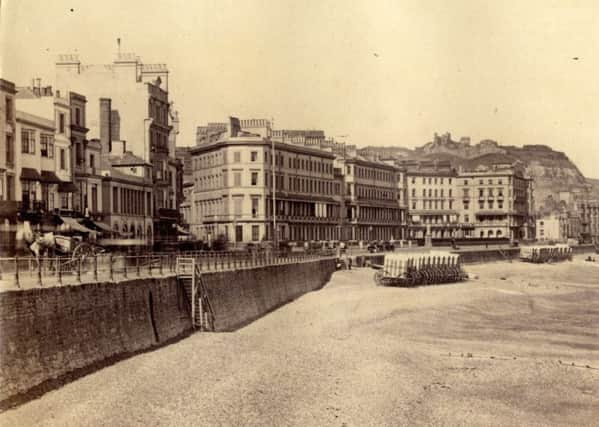

He writes: By the end of 1869 work had started on building Hastings Pier with the first iron pile being screwed into the seabed.
The contractor was Laidlaw & Son, of Glasgow, and the iron piles were delivered onto the beach at Warrior Square by sailing boat from Scotland. By July the following year about a third of the three hundred-odd piles of the new pier had been driven into the seabed and the pier, the new Hastings Pier - the ‘Peerless Pier’ - was officially opened by the Earl Granville, Lord Warden of the Cinque Ports, on 5th August 1872, a day recorded as being very wet and windy.
Advertisement
Hide AdAdvertisement
Hide AdThe new Hastings Pier was 910 feet long and 45 feet wide in the middle and the last section, holding the pavilion, was 300 feet long and 125 feet wide. It was the first pier in Britain to be built with a large entertainments pavilion as part of its design and attracted nearly half a million visitors in its first year.
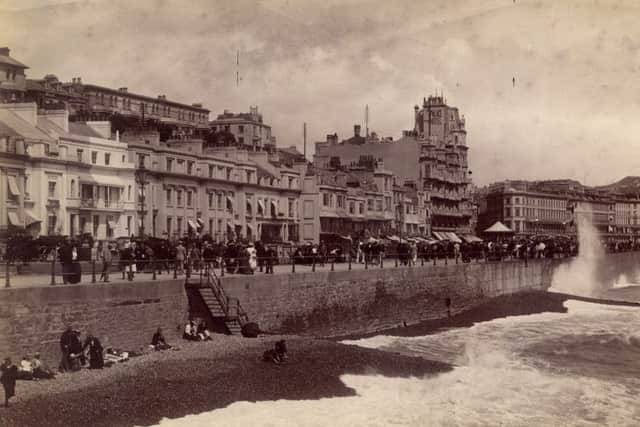

As a promenade pier many of the visitors would have been attracted by the magnificent views of the Hastings shoreline and inevitably photographers, amateur and professional local and ‘foreign’ would record these views.
The photographic process, whilst never cheap, was becoming affordable to the middle classes who would buy the photographs, the early ones printed individually on flimsy paper to be pasted into albums.
The dawn of the postcard era at the end of the nineteenth century would then provide an explosion in the number of views available.
Advertisement
Hide AdAdvertisement
Hide AdBecause we know when Hastings Pier was built we know that none of these photographs can date before 1870 even if the photographer was able to gain access to the unfinished structure and none appears to be later than the end of the nineteenth century so this series of photographs shows the evolution of this area of the seafront over just a couple of decades.
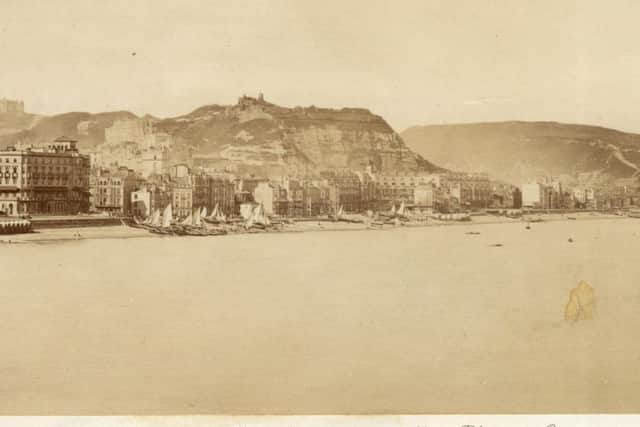

The view from the pier of the building line in the 1870’s is not vastly different to the view today, 140 years later, because the majority of the seafront buildings had all been constructed by the time the nineteenth century ended; the major difference of course is Sidney Little’s promenade constructed in the early 1930’s from the pier to Marine Parade, to the east of Pelham Crescent.
At White Rock, the Palace Hotel opened at the end of 1886 on the site of the White Rock Brewery which dated from 1831 and the Seaside Hotel. The Palace was considered at the time to be the best hotel in town - it was eight stories tall and had a frontage of 125 feet and depth of 80 feet. It had 140 rooms and three entrances including one from the sixth floor to Prospect Place on top of the cliff at the rear.
From Hastings Pier White Rock becomes Carlisle Parade where Robertson Street headed for ‘The Memorial’ and carried all the traffic into the town centre because Carlisle Parade ended at the Queens Hotel.
Advertisement
Hide AdAdvertisement
Hide AdSidney Little’s new parade (with the country’s first underground car parking beneath it) would alleviate the problem in the 1930’s.
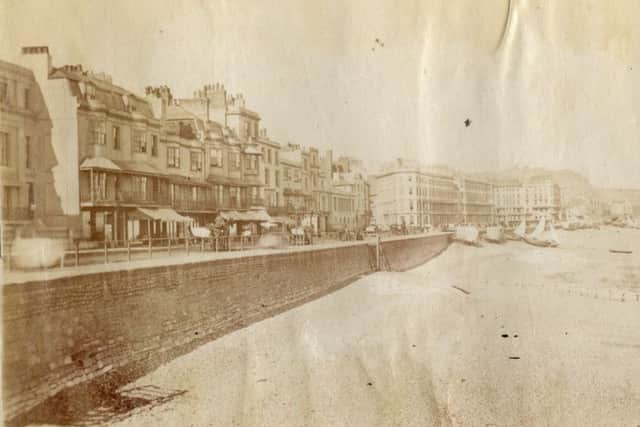

Carlisle Parade took its name from Lord Carlisle who was Chief Commissioner for Woods and Forests, the government body that appropriated the America Ground for the Crown.
Further east was Harold Place where the pleasure yachts were drawn up then Denmark Place, probably named after Alexandra of Denmark, Edward VII’s queen who had been Princess of Wales from 1863 – 1901 and who opened Alexandra Park, in 1882, the park was also named after her then comes Caroline Parade named after George IV’s popular queen before becoming the more mundane Pelham Place and Marine Parade.
The sea wall that is apparent in all of these images now forms the back wall of the underground car parks and can still be seen there today. In its early days there were no safety railings on the top of the sea wall.
Advertisement
Hide AdAdvertisement
Hide AdNone of the photographs give any indication of photographer or publisher.
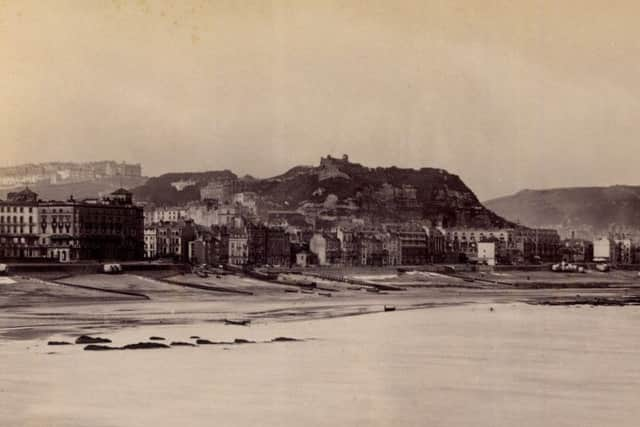

All illustrations throughout this series are from Ion Castro’s own collection and he can make available copies of many of the historic images used in this series. There’s more local history on Ion’s website, www.historichastings.co.uk or contact him - [email protected].
Captions:
Carlisle Parade.
The area occupied by the gentlemen’s bathing machines is now under Sidney Little’s promenade and underground car park. The buildings at the back of Robertson Terrace haven’t yet been transformed into the Albany Hotel which will be destroyed on May 23rd 1943 with loss of life amongst the Canadian troops billeted there, that air raid was the second heaviest wartime attack and also destroyed the Swan Hotel in the High Street. Gentlemen can be seen bathing in the sea.
Gentlemen’s Bathing Machines.
The sexes were segregated on the beach at this time - and small pleasure boats at Carlisle Parade and notice the washing drying on the beach. The shingle is high up against the sea wall.
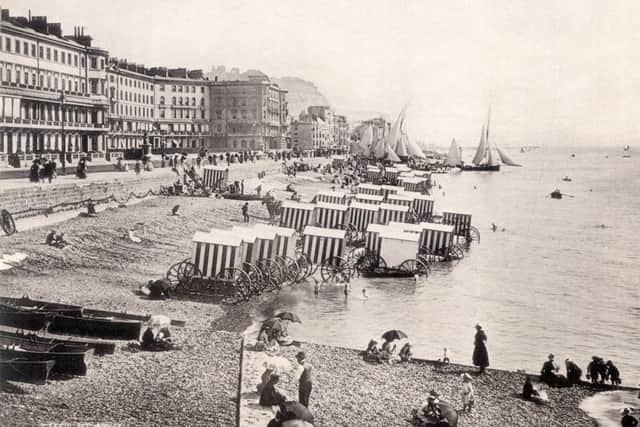

Hastings Castle.
Advertisement
Hide AdAdvertisement
Hide AdA fine panoramic view centred on the ruins of Hastings Castle, the tower of Emmanuel Church can be seen on the left and the view sweeps round to Rock-a-Nore on the right before the harbour or East Hill Lift were built. As we would expect washing can be seen drying on the beach.
Hastings From the Pier, Sussex.
Captioned ‘Hastings From the Pier, Sussex’ , notice the windmill on the West Hill on the left, - There had been three mills in the Priory Road/ Plynlimmon Road, area and there was also a steam mill, its tall chimney that can be seen immediately to the right of the windmill. Two of the windmills were sold and dismantled during 1874 and the land auctioned in 24 plots and the last of the three windmills standing on the West Hill had been pulled by the end of the year. Notice the pleasure yachts pulled up on the beach by the Queens Hotel and the blocks of bathing machines. Still no harbour - that would come in 1895 and the East Hill Lift would have to wait until 1902.
Palace Hotel.
Opened in 1886 The Palace Hotel still dominates this part of the seafront towering above the earlier buildings, its top on a level with the buildings on top of the cliff. Notice the telephone poles, looking like bottle-brushes above the exchange at 52 Cambridge Road, erected in 1894. The telephone exchange moved to the Post Office at the bottom of Cambridge Road in 1930.
Robertson Terrace and Bathing Machines.
After 1874 because there’s no windmills on the West Hill and notice the washing on the beach as well as the number of small boats and the row of bathing machines.
The Beach.
Advertisement
Hide AdAdvertisement
Hide AdPictured toward the end of the nineteenth century, some of the bathing machines are in the water, were they horsedrawn or manually moved? Notice that there’s no safety railing on the sea wall and notice too the pleasure yachts drawn up by the Queens Hotel and the umbrellas used as sunshades.
White Rock and Carlisle Parade.
The Seaside Hotel is not yet in place to the right of the White Rock Brewery, (the low building in the centre of the photograph), both will be replaced in 1886 with the Palace Hotel. Safety railings have now appeared on the top of the sea wall. The flimsiness of the photographic paper is evident in the creasing where the picture has been pasted into an album.
White Rock Brewery.
The White Rock Brewery, clearly not a tower brewery, is the low building in the centre of the photograph. The brewery and the building to its right, the Seaside Hotel will both be replaced by the Palace Hotel in 1886. Notice the segregated bathing machines, the gentlemen’s machines are nearest to the camera with the ladies’ some distance away – further away from telescopes on the pier? The access ramp to the beach, - where bathing machines and boats were drawn up onto the promenade during rough weather – can be seen just to the left of the nearer machines.
Benefit from an ongoing discount on your (paper title) by joining our voucher membership scheme. Once you’ve subscribed we’ll send you dated vouchers which can be exchanged for your paper at any news outlet. To save money on your (paper title) simply click here (www.localsubsplus.co.uk)